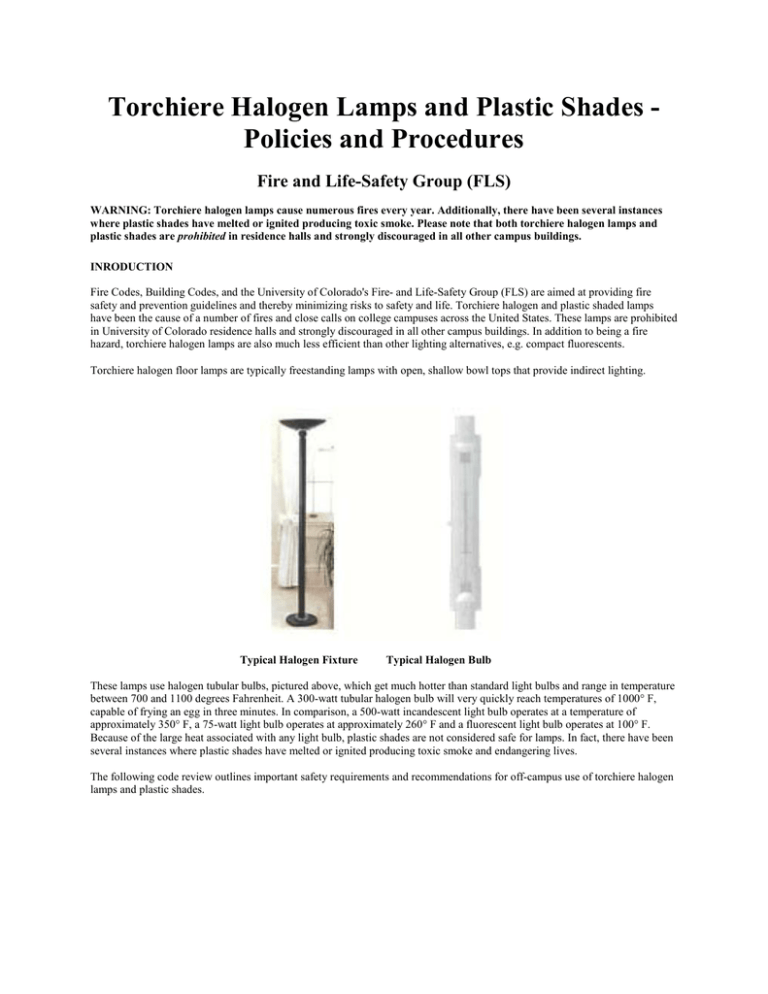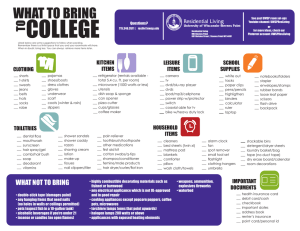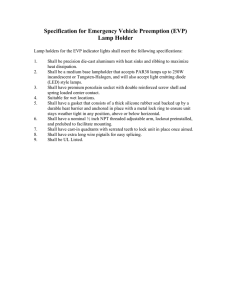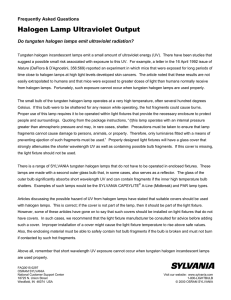Torchiere Halogen Lamps and Plastic Shades
advertisement

Torchiere Halogen Lamps and Plastic Shades Policies and Procedures Fire and Life-Safety Group (FLS) WARNING: Torchiere halogen lamps cause numerous fires every year. Additionally, there have been several instances where plastic shades have melted or ignited producing toxic smoke. Please note that both torchiere halogen lamps and plastic shades are prohibited in residence halls and strongly discouraged in all other campus buildings. INRODUCTION Fire Codes, Building Codes, and the University of Colorado's Fire- and Life-Safety Group (FLS) are aimed at providing fire safety and prevention guidelines and thereby minimizing risks to safety and life. Torchiere halogen and plastic shaded lamps have been the cause of a number of fires and close calls on college campuses across the United States. These lamps are prohibited in University of Colorado residence halls and strongly discouraged in all other campus buildings. In addition to being a fire hazard, torchiere halogen lamps are also much less efficient than other lighting alternatives, e.g. compact fluorescents. Torchiere halogen floor lamps are typically freestanding lamps with open, shallow bowl tops that provide indirect lighting. Typical Halogen Fixture Typical Halogen Bulb These lamps use halogen tubular bulbs, pictured above, which get much hotter than standard light bulbs and range in temperature between 700 and 1100 degrees Fahrenheit. A 300-watt tubular halogen bulb will very quickly reach temperatures of 1000° F, capable of frying an egg in three minutes. In comparison, a 500-watt incandescent light bulb operates at a temperature of approximately 350° F, a 75-watt light bulb operates at approximately 260° F and a fluorescent light bulb operates at 100° F. Because of the large heat associated with any light bulb, plastic shades are not considered safe for lamps. In fact, there have been several instances where plastic shades have melted or ignited producing toxic smoke and endangering lives. The following code review outlines important safety requirements and recommendations for off-campus use of torchiere halogen lamps and plastic shades. In addition, the Fire- and Life-Safety Group and the Energy Conservation Officer are currently committed to providing alternatives to using torchiere halogen lamps. Please contact the Fire- and Life-Safety Group at 303-492-4042 or the Energy Conservation Officer at 303-492-1425 with regard to replacement lighting options and support. NOTICE: Letter from the Campus Fire Marshal, Zachary Niehues and the Energy Conservation Officer, Moe Tabrizi. During the week of March 1st, 2005, a torchiere halogen lamp caused a fire in a University building on the Boulder campus. Please not that the use of torchiere halogen lamps is prohibited in dormitories and is strongly discouraged in all other buildings and facilities because of the increased fire risk and high-energy demands. Please report the use of halogen lamps to the campus Energy Conservation Officer, Moe Tabrizi, 303-492-1425, and he will try to provide alternative lighting accommodations, e.g. permanent installations or other energy efficient lighting options. Code Requirements and Guidelines According to the Guide for Fire and Explosion Investigation (NFPA-921), the upper end of the temperature range for this type of lighting device can reach temperatures that will enable the automatic ignition for most types of wood. The automatic ignition temperature is the temperature required for a material to ignite without the presence of a flame or spark. For most types of wood, this occurs at 600 degrees Celsius or 1112 degrees Fahrenheit. ACTIONS TO BE TAKEN TO ENSURE COMPLIANCE 1. 2. 3. 4. 5. 6. 7. 8. 9. 10. 11. 12. 13. 14. 15. 16. 17. 18. 19. Halogen floor lamps manufactured before February 1997 are not be used. Use only lamps that have been tested by Underwriters Laboratories (UL). UL approved lamps meet the following test requirements (note: do not attempt to perform these tests): • The cheesecloth drape test. In this test, a 20-layer pad of cheesecloth is draped over the lampshade for seven hours with the lamp on. The cloth must not catch fire; no layer should develop holes. • The lamps must also pass another fire test in which the lamp is set so it touches a vertical wall surface covered with untreated cotton terry cloth for seven hours without the wall igniting. • Any lamps not designed with "tip-over switches" must pass a 12-degree stability test, which measures how prone the light fixture is to being knocked over. Use only lamps that have been fitted with glass or wire bulb guards. Carefully read all safety instructions, warnings and markings that accompany the product before use. Never place torchiere halogen lamps where the tubular bulb could come in contact with curtains or any other combustible materials. Never place materials such as clothing or towels on the top of a torchiere lamp. Never use torchiere lamps in children's bedrooms or playrooms. Children may play with lamps or unknowingly place combustibles, such as stuffed toys or clothing, too close to the bulb area. Never place a torchiere lamp near an open window where a strong breeze could blow drapery onto the lamp bulb. Never leave a torchiere lamp on when you leave the room or are not at home. For torchiere lamps equipped with a dimmer switch, operate the lamp at a setting lower than the maximum whenever possible. Keep halogen torchiere lamps away from elevated beds, like bunk beds or lofts, where bedding might get too close to the halogen bulb. Avoid placing lamps in locations where they may be easily tipped over by children, pets or other means. All halogen torchiere lamps must have a date of manufacture posted on the unit. The Consumer Product Safety Commission (CPSC) recommends replacing 500, 300, and 250-watt halogen bulbs with cooler burning 150-watt bulbs or less. Always turn off or unplug the lamp before removing or replacing bulbs. Never replace a bulb with one of a higher wattage or different design. Never attempt to replace or discard a bulb that is hot to the touch. Never operate a lamp with missing or damaged components. Retrofit Safety Kits for Existing Halogen Torchiere Floor Lamps The CPSC and the halogen lamp industry are cooperatively recalling, for in-home consumer repair, approximately 40-million halogen torchiere floor lamps. Consumers who own halogen torchiere floor lamps without a glass or wire guard over the glass bulb shield can receive a free wire guard with installation instructions from several different national-chain retail stores, which are helping the industry make the guards available to consumers. Consumers can check with the CPSC to find participating stores. Consumers should not return the lamps to the retail stores. If consumers cannot get to a store for a free repair kit, they can receive the guard by calling (800) 985-2220. This program only applies to torchiere floor lamps using halogen bulbs. Please click here for more information regarding retrofits, safety and other issues pertaining to the use of torchiere halogen lamps.



